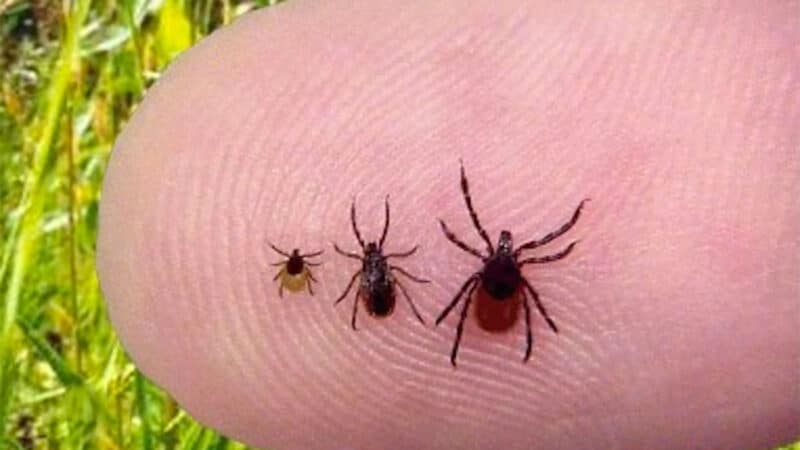by Dr. Sarah Treanor Bois, PhD
Director of Research & Education at the Linda Loring Nature Foundation
With FIGAWI in the rearview mirror, it really feels like summer is upon us on the island. As we all start to spend more time outdoors on our conservation trails, we come into contact more frequently with one of the few hazards we have on Nantucket. We don’t have skunks, bear, coyotes, or venomous snakes. We do, however, have ticks. Late spring/early summer is a boon time for ticks, but with a mild winter and temperatures rarely going below freezing, ticks on island have been active all year round.
Whether you live here or are just visiting, it’s important to arm yourself with knowledge before heading out. So what ticks do we have on Nantucket?
The Black-legged tick (formerly called the deer tick) was our primary worry for a long time since they spread the Lyme disease-causing spirochete, among other infections. These ticks are found predominantly in woody, shrubby habitats. Research has shown that they prefer the humidity of understory shrubs. Their numbers rely greatly on the distribution of its reproductive host: white-tailed deer. On Nantucket, this is our most common tick.
In recent years, the Lone Star tick has been increasing in number across the island. Lone Star ticks are notable for the distinctive white dot on their reddish-brown bodies which is actually only found on adult females. The adult males have white dots or streaks on the outer edges of their bodies. Nymphs are smaller and distinguished by reddish-brown bodies and fast speed. Yes, they will run up your clothes upon contact.
Historically, from south-eastern, south-central, and mid-Atlantic states, their distribution has been expanding with warming temperatures of climate change. The expanding range of Lone Star ticks in New England now includes populations in coastal Connecticut, Rhode Island, Massachusetts, and Maine. And they co-occur with Black-legged ticks in coastal Massachusetts, including Cape Cod and the islands.
Lone Star ticks have similar life stages as the more familiar Black-legged ticks —larva, nymph, and adult—but they are able to complete their life cycle in one year. Lone Stars are known to be more aggressive than other ticks, seeking out a blood meal by following the carbon dioxide. Their bite is said to hurt because they have longer mandibles, which might make them easier to detect and remove before disease transmission.
The good news is that Lone Star ticks are less likely to carry pathogens than Blacklegged ticks. Lone Star ticks can transmit several disease agents and sometimes cause a delayed red meat allergy “alpha-gal syndrome,” which can show up months after a tick bite. Lone Star ticks don’t transmit Lyme Disease, but they can carry tularemia, human ehrlichiosis, and STARI (southern tick associated rash illness), but the prevalence of these infections is much lower.
There is little known in the medical field about alpha-gal syndrome (AGS) and it is a growing area of research. AGS affects people differently, with symptoms ranging from mild irritation to anaphylactic shock when consuming mammalian meat products. Some people, with management over time, have had their allergy go into remission. Two people I know who have tested positive for AGS had very different initial symptoms and have been managing their allergy with the help of their doctors.
Dr. Allison Snow has been researching the ticks of Nantucket for the past three years. Her research, funded in part by the Nantucket Biodiversity Initiative, was conducted in an effort to provide a baseline for Nantucket on tick populations as well as infection rates. Tick densities and infection prevalence were recorded for study sites on Nantucket and Tuckernuck islands. Her study involved dragging sampling cloths and collecting data on the surrounding vegetation at each site. Nine sites around Nantucket, plus one on Tuckernuck, were sampled this way.
The results of this study were recently compiled for publication. During her study, Dr. Snow didn’t find dog ticks at any of the sites. While they have been found in the past on Nantucket, there is some evidence that the newer, more aggressive tick species are outcompeting the dog ticks.
Dr. Snow found that, for Black-legged ticks, nymphs were most abundant at shadier sites and least common in grasslands and scrub oak thickets. The infection rate varied by year but was, on average, for Nantucket: 10-20% infection rate for Borrelia burgdorferi (the Lyme Disease spirochete), 11-15% for Babesiosisi, and 17% for Anaplasmosis. The rates were higher for the Tuckernuck samples, as was the rate of co-infection.
Results also showed that Lone Star nymphs and adults were extremely abundant on Tuckernuck. Lone Star ticks were rarer on Nantucket, but the numbers captured increased each year of the study and were found primarily at study sites on the western end of the island.
While she cannot speculate on the amount of time it will take, Dr. Snow expects that eventually Lone Star ticks will become well established across Nantucket. The silver lining (if we can call it that) is that the Lone Star ticks tested on Nantucket and from elsewhere in Massachusetts have had low prevalence of infection. Currently, the greatest health threat from Lone Star ticks on Tuckernuck and Nantucket may be acquiring the alpha-gal allergy to red meat. This is an emerging area of research with new and diverse reaction to the infection.
From Allison Snow’s research: “Compared to Black-legged ticks, Lone Star ticks lay more eggs per female (~5,000 vs. 3,000), have better nymphal survival, are more attracted to CO2 emitted by hosts, quest for bloodmeals in more habitats, move greater distances, move more quickly, and do not rely on small mammals for bloodmeals during their immature stages, instead feeding mainly on deer. Lone Star ticks occur primarily in woods and adjacent areas but are often found in grassy habitats as well.” As someone who spends a lot of time in Nantucket’s open space, I’m learning that Lone Star ticks will require even more diligence that prevention for Black-legged ticks.
“The adults and nymphs of Lone Stars are common in June. Unlike deer ticks, which are sensitive to low humidity, Lone Stars don’t mind being in open, sunny habitats, including lawns,” Dr. Snow says about the Lone Star Ticks. “On Nantucket, their distribution is still patchy and mostly on the western end of the island, but people are encountering them other places, too. The situation on Nantucket could follow what has happened on the Vineyard, where they are especially common in Aquinnah and on Chappaquiddick.”
Dr. Snow’s work has been submitted for publication, but her research hasn’t ended. She’s taken her sampling methods to Martha’s Vineyard in the next step of investigating tick population, infection rates, and potential spread.
What’s the best way to protect yourself from ticks on Nantucket? Staying on paths, and checking clothes after being outside are good initial steps. Dogs should be treated with a preventative, and you may want to explore vaccine options for your dog (like the Lyme vaccine). Treating clothing with permethrin can be a big help. I never thought I would recommend a chemical, but with the rise of Lone Star ticks in particular and considering their tenacity, I have started treating my field pants with permethrin. Do not put it on your skin, but permethrin clothing and spraying on shoes can help keep ticks from biting you.
Dr. Snow notes, “When I was working on Tuckernuck, I didn’t want to walk on the grass or in the woods without being totally covered up and carrying a lint roller for removing them from my clothes before they got to my neck. (Note – so far, compared to Tuckernuck, they are a lot less abundant in places where they occur on Nantucket.)”
For more information about prevention, what to do about ticks in your yard, or actions to take if you’ve been bitten, the Cape Cod Cooperative Extension program has a wealth of information posted on the Barnstable County Website: capecod.gov/departments/cooperative- extension/programs/ticks-bugs/. Cape Cod Cooperative Extension entomologist, Larry Dapsis, populated this website including a series of “Tick Talks”: short videos about the ticks found on Cape Cod, prevention, and more. Even though it’s based on the Cape, the information is very relevant for Nantucket.
With research, cooperative knowledge, and information sharing, we can all continue to enjoy the out of doors. And, hey, at least we still don’t have any coyotes.



